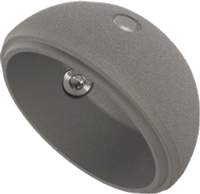You are here
SeleXys TH+ and TPS acetabular shells used in hip replacements
Consumers and health professionals are advised that Mathys Orthopaedics, in consultation with the TGA, has issued a hazard alert for its seleXys TH+ and TPS acetabular shells used in hip replacements due to higher than expected revision rates.

A seleXys TH+ acetabular shell.

A seleXys TPS acetabular shell.
An acetabular shell is the "cup" that is placed in the acetabulum (the "socket" part of the hip joint) during a hip replacement procedure.
An analysis of data from the Australian Orthopaedic Association’s National Joint Replacement Registry (AOAJNRR) indicates that the revision rates for seleXys TH+ and TPS acetabular shells are higher than expected. This analysis also identified early loosening/lysis as the reason for the higher rates of revisions.
Mathys Orthopaedics ceased supply of seleXys TH+ acetabular shells in April 2013 and seleXys TPS shells in June 2014. Both have been cancelled from the Australian Register of Therapeutic Goods.
The seleXys TH+ and TPS are not to be confused with the seleXys PC acetabular shell, which is not included in this hazard alert. The seleXys PC has been in use in Australia since 2007 and no cup revision has been reported so far.
The catalogue number ranges of seleXys acetabular shells affected by this hazard alert are:
- seleXys TH+ acetabular shell (55.42.0142 to 55.42.0164)
- seleXys TPS acetabular shell (55.40.0042 to 55.40.0064)
Information for consumers
Mathys Orthopaedics has written to orthopaedic surgeons who have implanted or are treating patients who have been implanted with the affected devices providing further information about this issue.
If you are not sure what type of hip replacement you have, or if you have concerns about your hip replacement, particularly if you have symptoms such as pain or instability, you should contact the surgeon who performed the implantation or the hospital where the operation was performed.
Information for health professionals
Mathys Orthopaedics has written to orthopaedic surgeons who have implanted or are treating patients who have been implanted with the affected devices providing further information about this issue, including advice to assist with following up and treating those patients.
Patients with any hip replacement should be followed up by the implanting orthopaedic surgeon, particularly if they complain of pain and other symptoms associated with their hip implant and/or surgery.
Information for orthopaedic surgeons and hospitals
An analysis of the AOAJNRR data indicates that the individual revision rates were 4.28 revisions per 100 component years for seleXys TH+ acetabular shells and 1.79 revisions per 100 component years for seleXys TPS shells. The revision rate for all other total conventional hip replacements was 0.68 revisions per 100 component years.
The TGA recommends that you consider contacting patients who have been implanted with these devices and inform them of this issue.
Implanting surgeons are advised to maintain their routine follow-up protocol for patients who have undergone hip arthroplasty. The need for any additional follow-up or revision surgery should be determined on a case-by-case basis following a detailed assessment of the patients' clinical circumstances.
According to data published by the AOANJRR, the most common reason for revision of hip implants with a seleXys component is loosening/lysis, accounting for 57.6% of revisions. More than 66% of the revisions of hip implants with a seleXys component involved the seleXys acetabular component only.
Reporting problems
Consumers and health professionals are encouraged to report problems with medical devices. Your report will contribute to the TGA's monitoring of these products. For more information see the TGA Incident Reporting and Investigation Scheme (IRIS).
The TGA cannot give advice about an individual's medical condition. You are strongly encouraged to talk with a health professional if you are concerned about a possible adverse event associated with a medical device.



